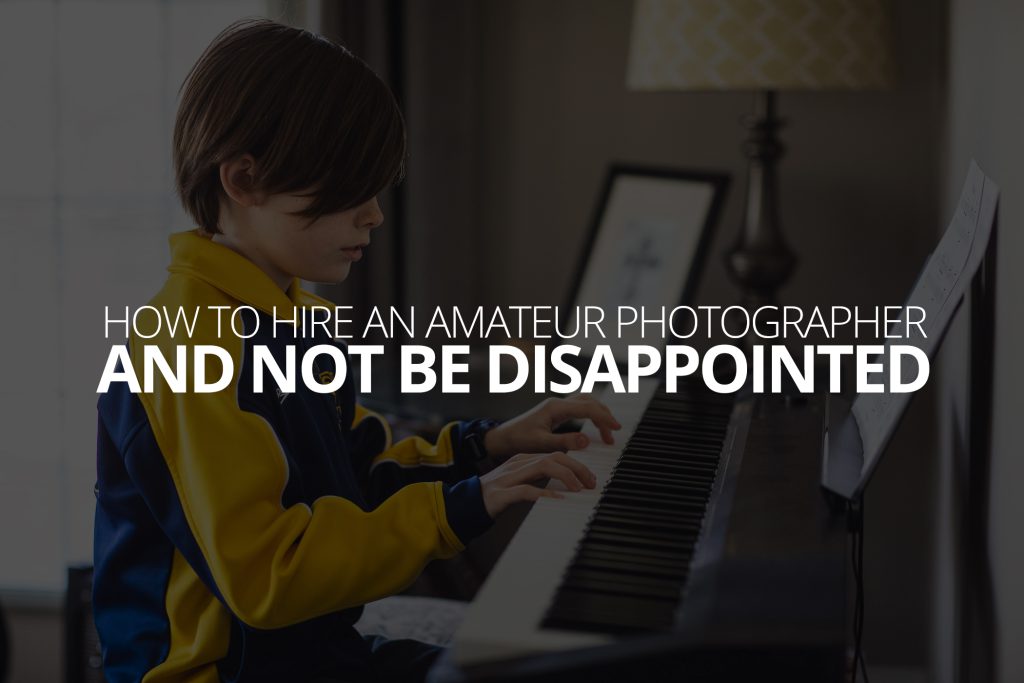What’s the difference between an amateur and a professional photographer? There’s no easy answer to that. Depending on which amateur and which professional, the difference may not be significant. Maybe there’s none at all. But, in general, the difference is probably not so much what they do with their camera, it’s probably mostly in how they interact with you before, during and after the session, and in how they respond to the unexpected.
Of course, my obvious bias here is that you should hire good, experienced professionals to create images of and for you—especially when talking about really important things, like weddings. But, I know that’s not realistic for a lot of people. After all, some images you can afford—even if they happen to be crappy ones—are better than no images because you can’t afford them. So, I thought I’d take the time on the blog this week to discuss how to go about hiring an amateur photographer so that you get the best experience and images you can from an unlikely candidate.
Step one is realizing that you are not hiring a professional, and should not expect a polished or professional experience. So lets go.
Adjust your expectations
That’s right. Planning or communicating may be slow. It might leave question marks hanging before the session that the photographer doesn’t know how to answer. They probably won’t know how many images you can expect, or have a good estimate on how long it’s going to take (whatever they tell you was probably made up on the spot). It’s unlikely that they’ll have a bunch of cool locations to work with up their sleeve. The images may be edited sporadically or inconsistently, or they might not be edited at all. Depending on the person, it could be weeks or months before you see any of the images.
None of this is necessarily a problem. Inconvenient, or cumbersome, maybe, but not necessarily a problem. So, if you want to have a good experience with an amateur photographer, setting expectations low is a good idea. Decide ahead of time that these sorts of things aren’t going to bother you. In fact, decide ahead of time that almost nothing (aside from outright rudeness, or cruelty of some kind) is going to bother you. The photos might be really amazing, or they could be downright awful. Just keep in mind that this person isn’t a professional and will probably need broad exceptions in order to give you an experience you’re pleased with.
look for sincere passion and future goals
By my general estimation, there are approximately two kinds of amateur photographers: Amateurs just trying to shoot for a quick 75 bucks, and amateurs who are just trying to shoot (and want that 75 bucks). What I mean by that is that it’s rather easy to get good enough with a camera to make a few bucks here and there, and that’s all a lot of amateurs are doing. It’s not a side job, it’s not even a side gig, and never will be. It’s just an easy way to offset the bar tab. Frankly, you don’t want to hire those people; they’re just a little more than an expensive, fleshy tripod.
Amateurs who are driven by a passion for photography, on the other hand, are the kind of people you want to find. Even though they shoot because they want to, it’s still reasonable for them to ask for money when they’re shooting for you, but it’s their passion and interest in photography outside of any payment that makes it more likely you’ll get something unexpectedly beautiful from them.
You’ll know who these people are by the quality of the images in their portfolio, and the length at which they can talk about photography, and how much of that talking is made up of remarks about gear and equipment. Photographers love to talk about their gear, but truly passionate photographers have way more to say than what kind of camera or lenses they use or want to use. A sincerely passionate amateur generally isn’t especially concerned with their equipment, because when they think about photography, they tend to think in terms of visions and style, light, scene, shape and experience—not just equipment.
Assume they have almost no idea what they’re doing outside the camera
Only about half of what a photographer does is technical. Technical, as in knowing how to work a camera under various conditions, and making technical choices about how an image will look. The majority of the other half is made up of soft-skills: empathy, attitude, perseverance, problem solving, and so on. These kinds of skills pretty much only come from experience, and experience is what the amateur is lacking. Although the soft-skills don’t usually make the difference between a good photo and a bad photo, they do typically make the difference between a good shoot and a bad shoot—That is, unless you’re prepared to handle most of those soft-skills on behalf of the amateur you’re working with.
Your amateur photographer may know where the best light is, but may have no idea how to deal with your kid when they decide they don’t want their picture taken. They may be able to compose the scene in front of them like a champ, but might be at a total loss for what to do when an antsy wedding planner is breathing down their neck. They might know how to position you in a flattering way for a photo, but might be clueless as to how to get you to relax so you actually look good in that position.
When you decide to work with an amateur, at the same time, decide that you’re not going to rely on them for these kinds of things and plan a ton of extra time. You may also want to coach (or bribe) your spouse and children so they’re on their best behavior while shooting. You’ll want to cram some smile-inducing tricks up your sleeve, because the amateur probably doesn’t have any.
Take responsibility for the planning and follow ups
One of the benefits of working with a professional is that some significant portion of their lives is dedicated to honing the skills around their photographic discipline. As such, they take on a lot of the planning and critical thinking that goes into getting remarkable images. All you typically have to do is decide when, and what to wear.
If you’re working with an amateur, these sorts of responsibilities don’t necessarily have any elbow room in your photographer’s life, and they may not have any system for tracking the planning process of the shoot. It would be wise to expect communication to be slow or sporadic. If you find yourself getting frustrated waiting for your photographer to get back to you, remember that this is not what they do for a living, it’s something they do for love (that’s actually what amateur means). Responding promptly and professionally is the domain of experienced professionals, not amateurs, so take it easy on them. If you send an email or a text and haven’t heard back in 3 days, just send another friendly message to remind them. They’re probably not intentionally avoiding you, you’re just not at the top of their priority list.
They’re also unlikely to have many locations they can vouch for, or as I mentioned, even time to reply to your emails or phone calls in a timely manner. You’ll likely need to do the research to find a good place, pick outfits, times of day, and coordinate some kind of written agreement yourself. Yes—you should make sure both of you sign something before you do that shoot, and the amateur probably doesn’t have anything for you to sign, so it’d be a good idea for you to come up with something yourself.
Plan your session with the easiest circumstances
This gets tricky because if you knew what the best circumstances were, you might try to take the photos yourself. But, if you’re hiring a photographer, it’s also setting them up for failure to plan a session under difficult circumstances.
So, what are difficult circumstances, you might ask? That’s an easy one—any time the available light, or the time, is restricted. For example, an amateur is unlikely to perform well during a stressful 20 minute shoot in a dimly lit hotel lobby. But, will likely perform fairly well in an open ended outdoor session on a lightly overcast day. While a professional can find beautiful images in a strip mall parking lot, an amateur needs all the help they can get. So set up the circumstances of your session to help them as much as possible.
Pick a time of day when the light is naturally beautiful—either sunrise or sunset—and choose a location that is beautiful in practically every direction. Think manicured gardens and historic sites.
Leave plenty of room for them to figure things out
One of the biggest difficulties amateurs have when taking on a session for someone is feeling like they need to look like they know what they’re doing. But if you provide them with plenty of space and time to figure things out as they go, they’ll be thankful and they’ll produce better images. But, and here’s the real kicker, they need to know that it’s okay for them to be figuring things out.
Make liberal use of language that lets them know you’re looking foreword to working with them, but you’re not expecting them to know or be capable of everything. Help your amateur photographer feel comfortable trying to advance their skills during your session. Make sure they know it’s okay to sprawl out and take the time they need to get what they want to get.
Of all the advice in this article, this one might be the most important. If you apply the expectations you might have for a professional, onto an amateur, you’re going to end up with rushed, distractingly imperfect images. But if you give them broad exception, you may just find a diamond in the rough.
Should you go for the amateur?
Well, that’s up to you. If the advice I’ve given here sounds unpalatable, then no, you probably should not. You’re likely to end up disappointed and maybe even cause a kind of rift in the relationship (supposing this person is a friend, as tends to be the case). On the other hand, if you don’t really object to any of this then, why not give it a try? 75-100 bucks isn’t all that much, and the worst case scenario, you go back and do it again with a professional.
If you decide to go the professional route, we’d love to hear from you! Just check out the Portrait Photography page here on our website and we’ll start a conversation about it!

